The evidence strongly suggests that the H-1B program is not working as intended. Despite efforts by the Department of Labor (DOL) to ensure that H-1B workers do not undercut wages of comparable U.S. workers, the data show that, in certain occupations, H-1B holders earn significantly less than their American counterparts. Furthermore, H-1B visa holders face limited upward mobility even though they often start at below-median wages. More fundamentally, the current system falls short by allocating visas through a random lottery rather than targeting specific labor market needs. Leaving such a critical policy to chance fails to address the demands of specialty occupations and undermines the program’s original purpose—to fill genuine skill gaps in the U.S. workforce.
To address these issues, the U.S. should replace the current lottery system with a wage-based selection process. This reform would involve rank-ordering applications by the salary offered from the highest to lowest. The proposed changes would prioritize higher-paid applicants and would discourage employers from offering below-market wages and ensure that H-1B visas are reserved for genuinely specialized and highly productive positions.
A History of the H-1B Program
For generations, the United States has attracted talented workers from abroad, many of whom have gone on to make this country their permanent home. The Immigration and Nationality Act (INA) of 1952 made a number of major changes to immigration policy, including establishing the foundation for employment-based immigration by creating the H-1 visa category for foreign workers with “distinguished merit and ability.”REF The H-1 program at the time was quite flexible, without detailed wage protections or numerical caps.
Four decades later, President George H. W. Bush signed into law the Immigration Act of 1990. The law split the existing H-1 program into separate programs: the H1-A for nurses (now obsolete) and the still existing H1-B program for other occupations. The law added annual caps on the number of visas offered, as well as Labor Condition Application (LCA)REF requirements to maintain certain wage levels for foreign nationals to engage in “specialty occupations.” Under Title 8 of the U.S. Code, Section 1184(i), a specialty occupation is defined as one that requires:
- A bachelor’s degree or higher in a field directly related to the job;
- Specialized knowledge in areas such as engineering, IT, finance, or health care;
- Professional licensing, when applicable; or
- Equivalent work experience (if a degree is not held), demonstrated through progressively responsible positions.
One of the most significant aspects of the H-1B program is its dual intent provision, codified in 8 U.S. Code § 1184(h).REF Unlike most non-immigrant (temporary) visas, H-1B holders are legally allowed to apply for permanent residency (a green card) without violating their temporary worker visa status. As a result, the H-1B program is a common pathway for foreign workers seeking long-term residence in the U.S. via a permanent employment-based visa.
A significant amount of publicly available data offers insight into the current state of the H-1B visa program. A careful analysis of this data raises concerns that the program, in its current form, is not achieving its intended goal of attracting top-tier global talent for truly specialized occupations. Instead, there is evidence that certain structural weaknesses have allowed participants to take advantage of the system in ways that deviate from the program’s original purpose, with larger companies often “winning the visa lottery” while crowding out smaller competitors. As a result, the United States is left with an inefficient program that is not centered on the United States’ highest-priority workforce needs and which harms U.S. workers. The following section discusses the structure of the program, followed by an analysis of publicly available data.
The analysis examines both LCA data and U.S. Citizenship and Immigration Services (USCIS) petition data.REF The USCIS petition data was obtained by Bloomberg News through a Freedom of Information Act (FOIA) request. The LCA data includes employer-submitted applications that outline key job details, such as title, wage, location, and employment dates. These applications are a required first step in the H-1B sponsorship process and must be certified by the DOL before an employer can proceed. The USCIS petition data, on the other hand, contains records of H-1B petitions submitted after an LCA is certified, including whether the petition was approved or denied. This dataset also includes additional details about the proposed employment and the beneficiary. By linking and analyzing these two datasets, it was possible to track the H-1B application process from the initial job offer to the final petition outcomes. The analysis also compares this data with the Occupational Employment and Wage Statistics from the U.S. Bureau of Labor Statistics (BLS),REF which allows analysis of wage patterns by occupational code.
First, however, this Backgrounder provides an operational overview of the H1-B program. Subsequently, it explores DOL and USCIS data to uncover trends in H-1B visa use, spotlight which organizations rely on them most, and analyze corresponding wage levels. This Backgrounder concludes with recommendations to help the H-1B program achieve its core goal: attracting top global talent to supplement, not supplant, the American labor force.
Overview of the H–1B Process
Figure 1 provides a visual representation of a common process for the various steps in the H-1B application process.
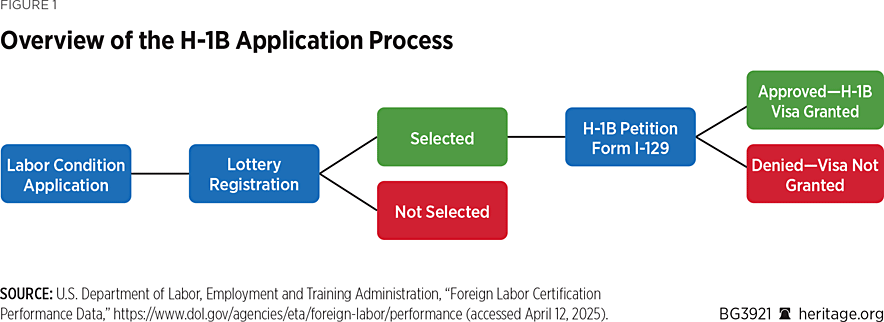
As Figure 1 shows, the H-1B application typically begins with an employer filing an LCA with the DOL. The LCA must be filed and approved before submitting the Form I-129 petition, though some employers may prepare both concurrently. The LCA outlines the job title, wage level, and work location, and affirms that the employer will pay the prevailing wage and comply with labor protections. Once the LCA is certified, typically a routine step unless there are errors, the employer may register the intended worker in the annual H-1B lottery conducted by the USCIS.
Subsequently, applicants register for the H-1B visa lottery. The lottery is a random selection process managed by the USCIS to allocate a limited number of H-1B visas—a maximum of 65,000 annually under the regular cap, with an additional 20,000 reserved for applicants holding a master’s degree or higher from a U.S. institution when visa demand exceeds supply.REF
If the selected worker is outside the United States at the time of approval, the individual must apply for an H-1B visa through the U.S. Department of State before entering the country in H-1B status. If the worker is selected in the lottery, the employer then submits a full H-1B petition (Form I-129) to the USCIS, using the previously certified LCA to support the filing. Since a Form I-129 may be denied, not all lottery selections result in approved visas.REF
An initial approval allows the visa holder to reside in the United States for up to three years. After three years, an employer can apply for a three-year extension, for a total of six years. Continued approvals are not subject to the lottery as the initial approvals are. After the six-year limit, an H-1B holder faces two possibilities: either he must leave the United States, or his employer must have initiated a process to file for a permanent employment-based visa (green card) while seeking one-year extensions for the temporary visa during the permanent visa process.REF
The following section provides an exploratory data analysis of H-1B data to help to understand how the program is currently operating and how it can serve its intended purpose.
Trends in H-1B Usage
Chart 1 depicts the number of approved H-1B visas since 2000.
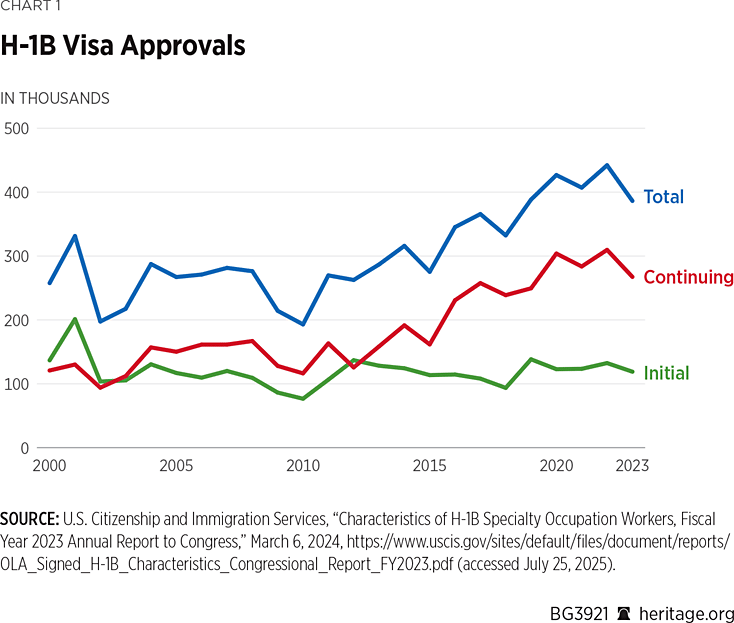
As Chart 1 shows, since the turn of the century, the number of total approvals has steadily increased, reaching nearly 450,000 in 2022 and 368,000 in the year 2023.REF Initial approvals, by contrast, have remained relatively flat over the same period, fluctuating between 100,000 and 180,000 annually, with a modest uptick in 2022 before dipping again in 2023. Continuing approvals, however, have seen a marked rise, more than doubling since 2011, and surpassed 250,000 in 2022 before falling slightly in 2023.
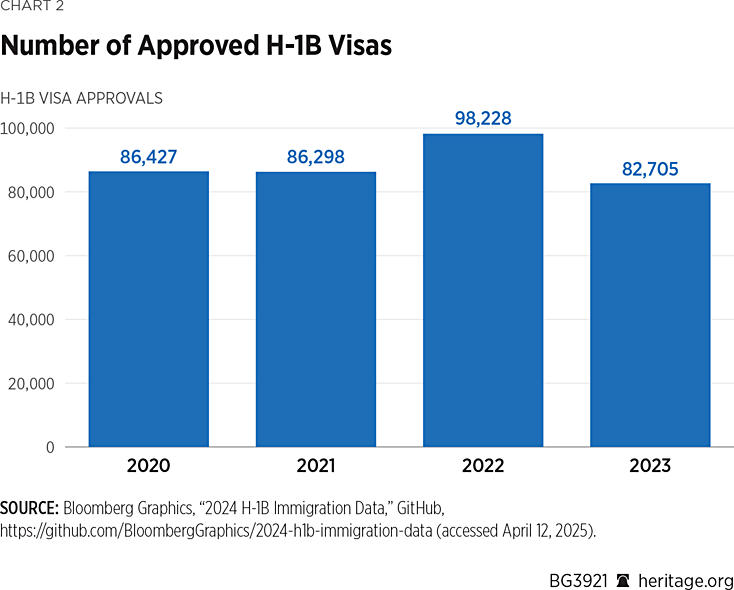
Chart 3 shows the breakdown of approved H-1B applications resulting from the lottery between 2021 and 2023 by nationality. In total these four years had 353,658 initial approvals that resulted specifically from the lottery process. This total does not include initial approvals granted to applicants sponsored by certain organizations, such as universities, nonprofit research institutions, and government research organizations, which are exempt from the annual cap and therefore not subject to the lottery.
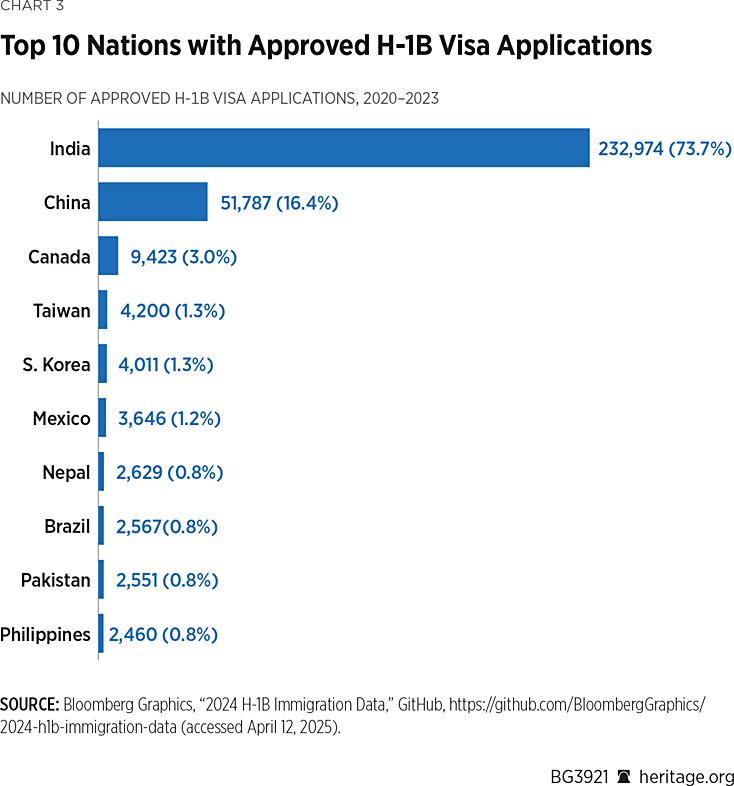
As Chart 3 illustrates,73.7 percent of all approved H-1B visas between 2020 and 2023 are exclusively among Indian nationals. China follows in second place, representing 16.4 percent of applications, followed by Canada (3 percent), Taiwan (1.3 percent), South Korea (1.3 percent), and Mexico (1.2 percent). All other countries worldwide constitute less than 3.5 percent of all approved H-1B visa applications.REF
Chart 4 depicts the distribution of the different levels of education amongst H-1B applicants between 2020 and 2023.
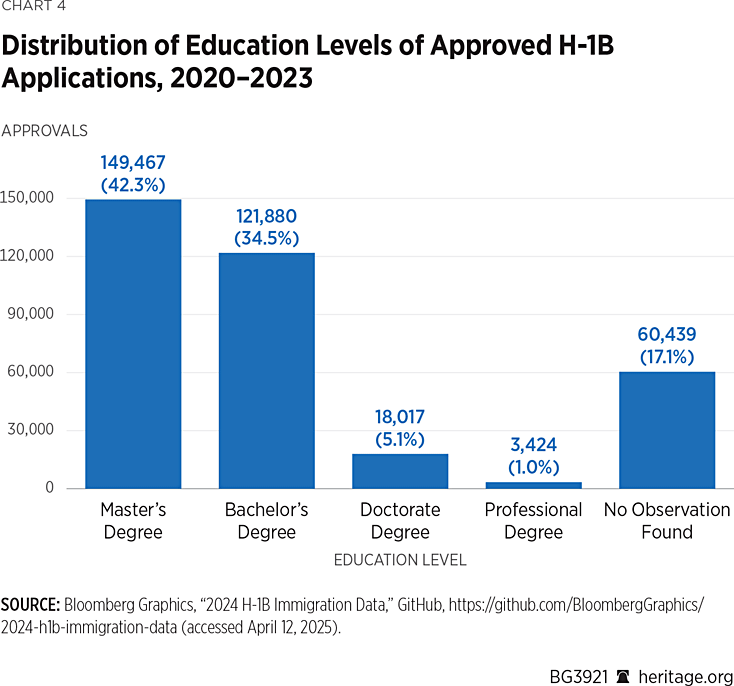
As Chart 4 illustrates, between 2020 and 2023, more than 75 percent of applicants had either a master’s or bachelor’s degree, and 5.1 percent of visa holders had a doctoral degree (PhD). Around 1 percent had a professional degree, such as a medical or law degree (MD or JD). An astounding 17.1 percent of observations did not have any information about the applicant’s registration, suggesting that the federal government has not adequately compiled data on the education status of one in six H-1B recipients.
It is also insightful to examine the prior visa classes of applicants approved for H-1B visas. Chart 8 displays these 10 most common prior visa classes for approved H-1B petitions from 2020 to 2024.
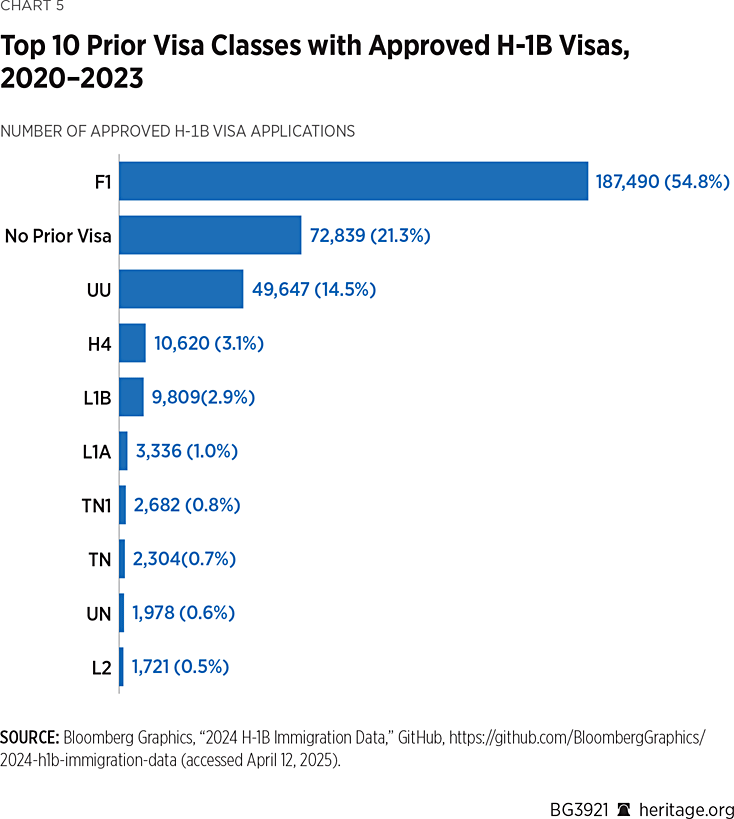
As Chart 10 shows, while 127 different visa classifications are recorded in the data, more than 99 percent of approvals fall within just the top 10. The F-1 visa (also known as the student visa) overwhelmingly dominates the list, representing 54.8 percent of all approvals. This statistic indicates that a significant majority of successful H-1B applicants were international students studying in the United States.
The second-largest category, comprising 21.3 percent, includes applicants listed as having “No Prior Visa” or missing data. Since the dataset does not differentiate between these two, this analysis assumes for simplicity that all such cases reflect applicants without a prior visa who were directly recruited from foreign countries.
The third most common entry, labeled “UU,” accounts for 14.5 percent of approvals. However, “UU” is not a valid visa classification—it is generally used as a placeholder for unknown or unreported prior visa status. Excluding this placeholder, the next most common legitimate visa class is H-4, which applies to dependents (typically spouses and children under 21) of H-1B visa holders. This group represents 3.1 percent of approvals, suggesting that a modest but notable share of new H-1B holders previously held dependent status.
Professional organizations that most frequently leverage the H1-B program are depicted in Chart 6.
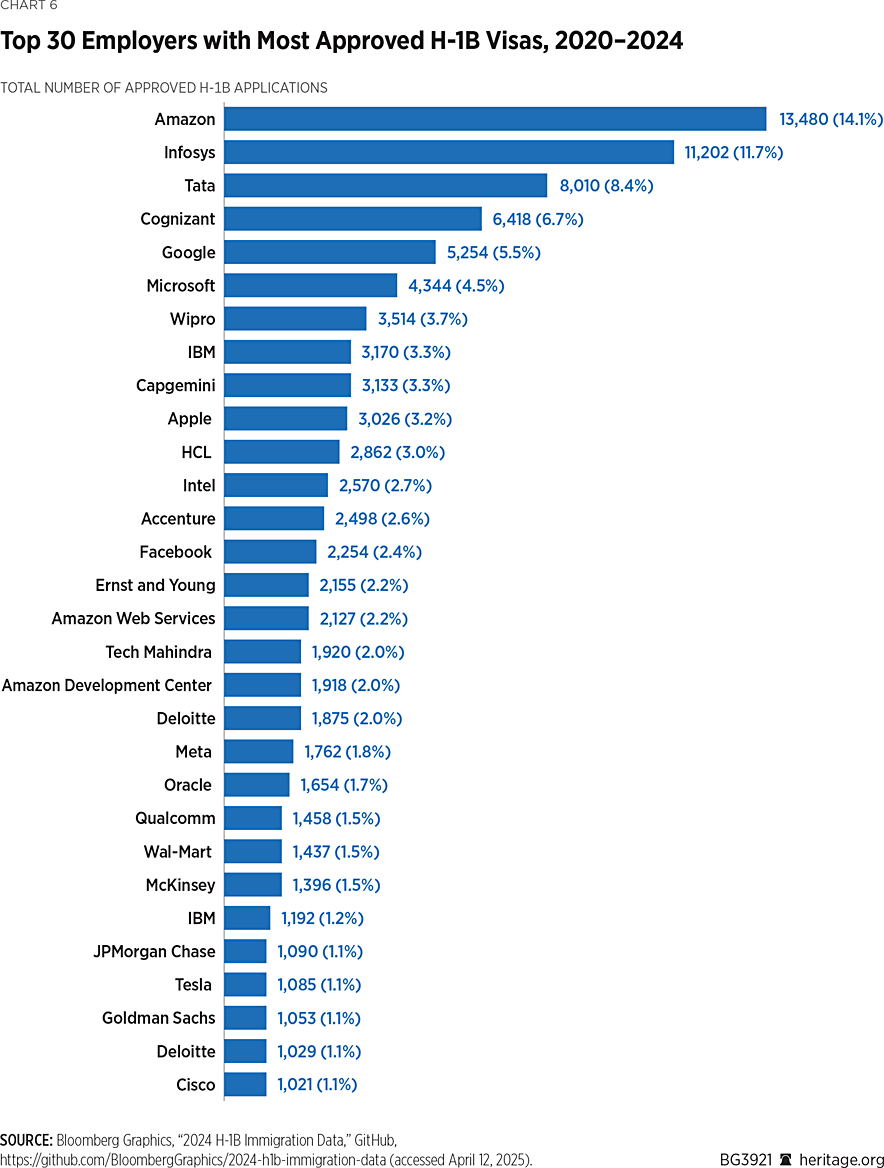
As Chart 6 shows, Amazon led all employers with the highest number of approved H-1B visa petitions between 2020 and 2024, with more than 13,000 approvals, representing 14.1 percent of all approvals among the top 30 employers. Amazon is followed by Infosys Limited, Tata Consultancy Services (TCS), Cognizant Technology Solutions, Google, and Microsoft, with shares of 11.7 percent, 8.4 percent, 6.7 percent, 5.5 percent, and 4.5 percent, respectively.
Notably, a significant portion of the top employers are IT services and outsourcing firms, such as Infosys, TCS, Cognizant, Wipro, and HCL America. These companies specialize in providing technical and consulting services to global clients, often by placing employees—frequently H-1B visa holders—at client sites in the United States. They serve a wide range of industries by offering services like software development, systems integration, cloud migration, and IT infrastructure management.
An Analysis of the Wages of H-1B Workers
There is also a significant amount of publicly available data on H1-B wages.REF To prevent wage suppression, the H-1B program requires that employers pay foreign workers the “prevailing wage” for comparable positions in the same geographic area. This wage standard is determined through the LCA, which employers must file with the DOL prior to petitioning for a visa. (See Chart 8.)
When filing the LCA, employers are also required to specify the wage level being offered to the prospective worker. The DOL defines four wage levels:
- Level I: Entry level (17th percentile)
- Level II: Qualified (34th percentile)
- Level III: Experienced (50th percentile/median wage)
- Level IV: Fully competent (67th percentile)
Wage levels vary by metropolitan statistical area (MSA) or area code, based on BLS geographic regions. For example, Table 1 provides data for the median salaries for the above salary designations in San Francisco County, California, and Mecklenburg County, North Carolina.REF
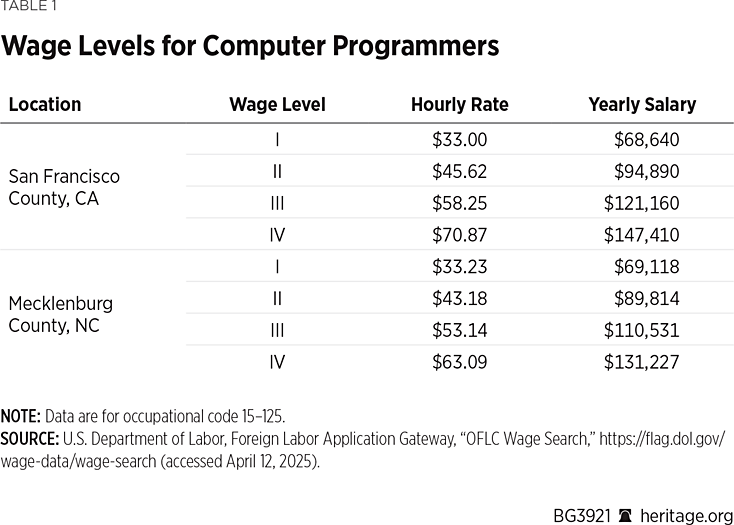
As one can see, the regional location of the job plays a role in determining the wage levels for these workers. Wage Level IV workers in San Francisco County earn much more than Wage Level IV workers in Mecklenburg County. This is the benefit of comparing wage levels, as these account for local wages.
The distribution of these wage levels for all certified LCAs between the years 2020 and 2024 is presented in Chart 7.
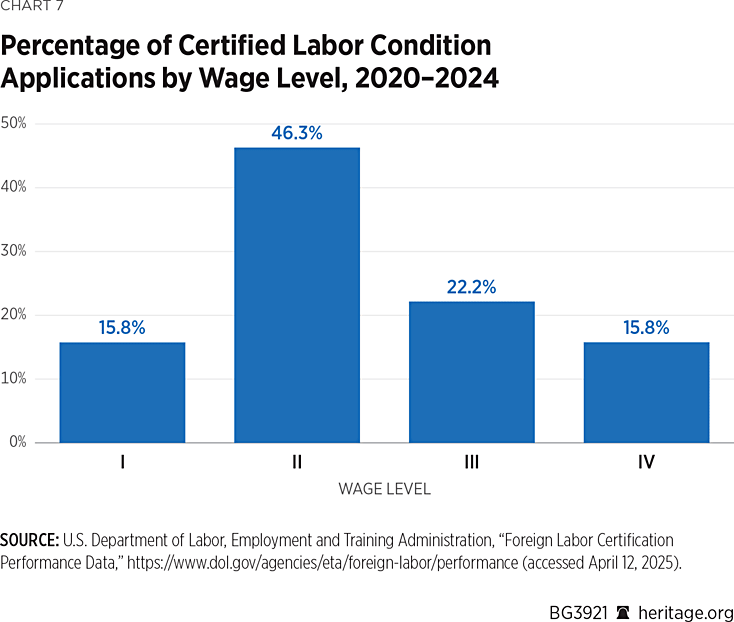
Taking into consideration the regional heterogeneity delineated in Chart 7, data from 2020 to 2024 show that only 15.8 percent of LCAs were filed at Level IV, while nearly half were filed at Level II. Furthermore, 15.4 percent of all applications were filed at Level I, the lowest possible wage tier. Although this data set reflects LCA filings rather than approved petitions, the distribution across wage levels suggests that many employers may be using the H-1B program not to attract top-tier global talent, but to fill roles at below-median wage levels—raising questions about the program’s alignment with its stated objectives.
Chart 8 presents wage-level breakdown amongst the top employers with the most certified LCAs between 2020 and 2024.
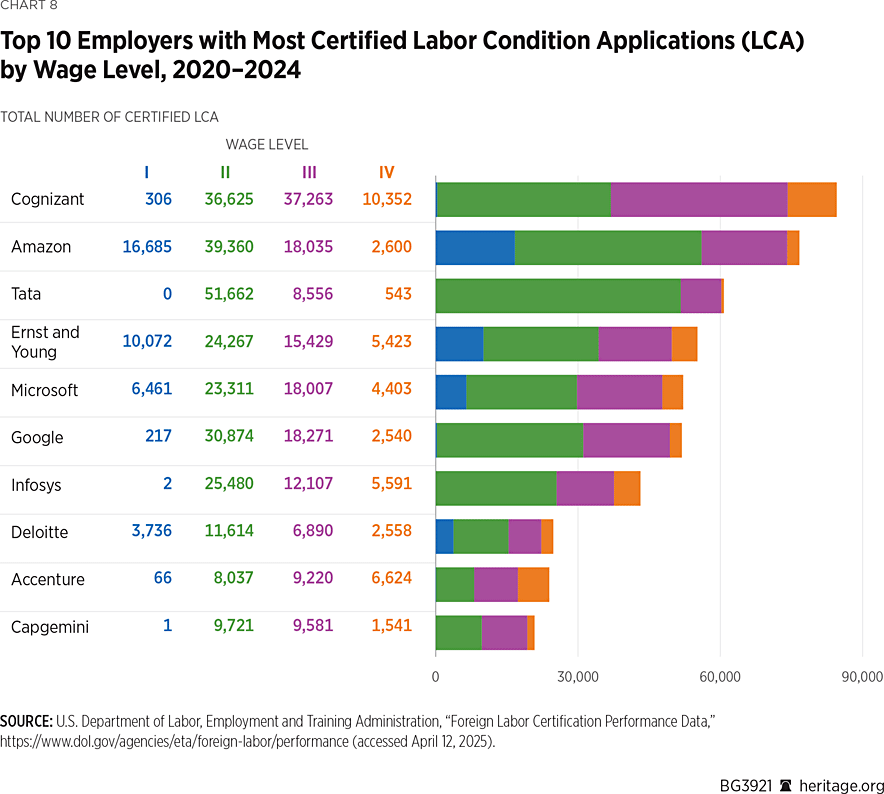
Chart 8 elicits a clear wage pattern. Infosys Limited, Google, Microsoft, Ernst and Young, Tata Consultancy, Amazon, and Cognizant appear to most frequently file Wage Level II applications (59.01 percent, 59.49 percent, 44.67 percent, 43.97 percent, 85.02 percent, 51.33 percent, and 43.32 percent, respectively). Amongst all organizations displayed, Amazon appears to file the most Wage Level I applications (21.76 percent), followed by Ernst and Young (18.25 percent) and Microsoft (12.38 percent). Overall, particularly in the IT services, the data suggest that these firms appear to file applications for the purpose of hiring lower-paid H-1B workers. Moreover, despite the program’s original intent to fill skill shortages in highly specialized fields, the LCA wage data suggests that talent sought through the H-1B pathway involve workers that are neither highly paid nor exceptionally specialized.
Chart 9 presents a bar chart as well as a series of box and whisker plots comparing salaries of H-1B workers to the general working population by profession using the Standard Occupational Classification (SOC) codes designated by the BLS. The lower and upper ends of each box represent the 25th percentile and 75th percentile, respectively, while the whiskers extend to the 10th percentile and 90th percentile.
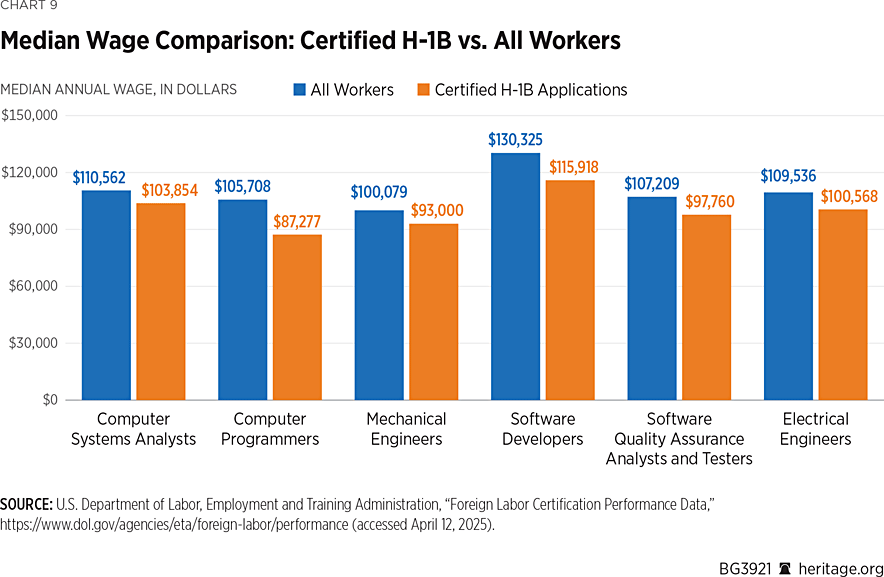
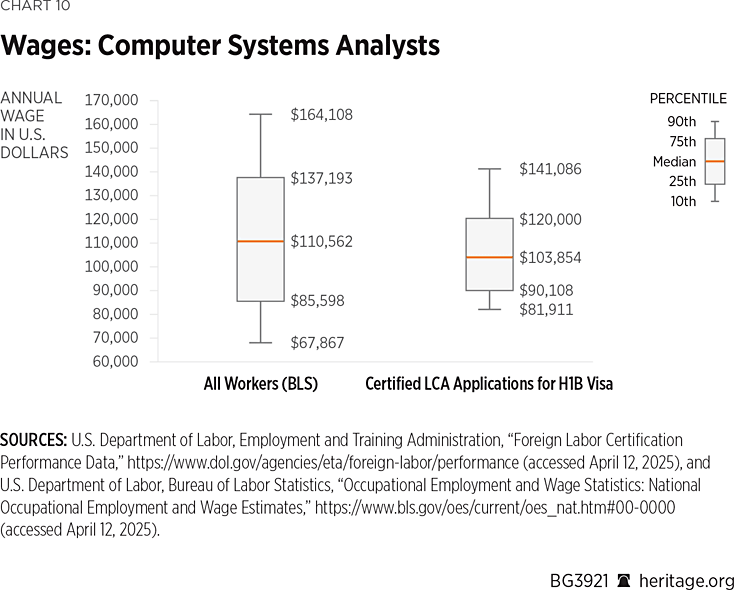
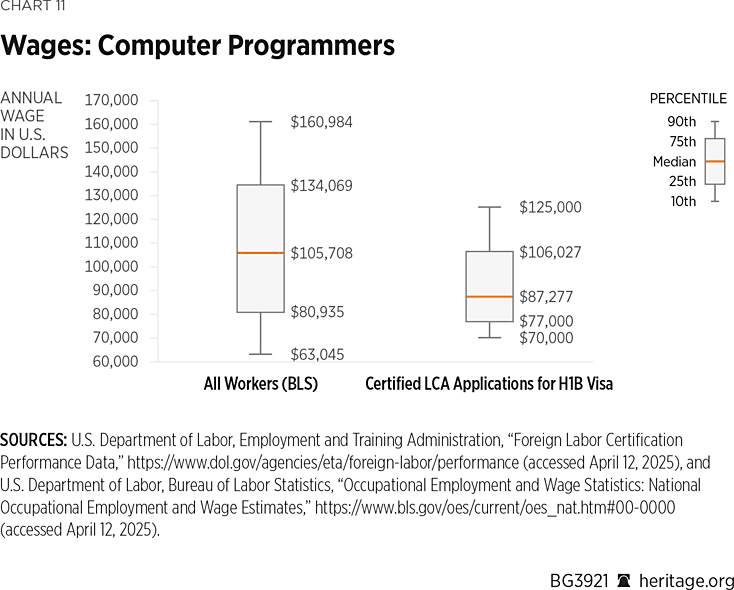
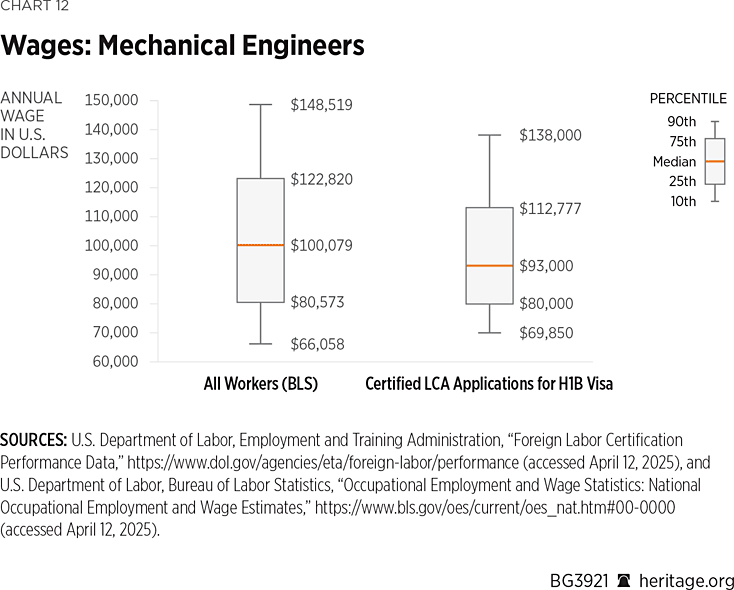
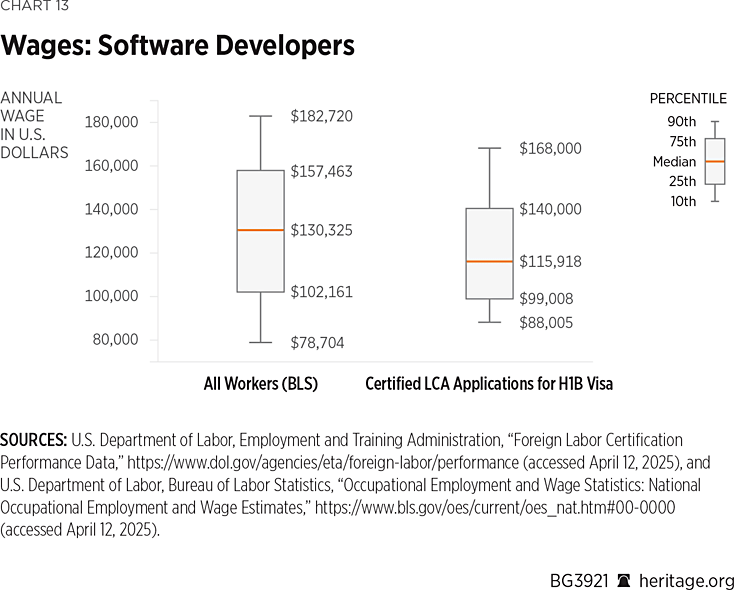
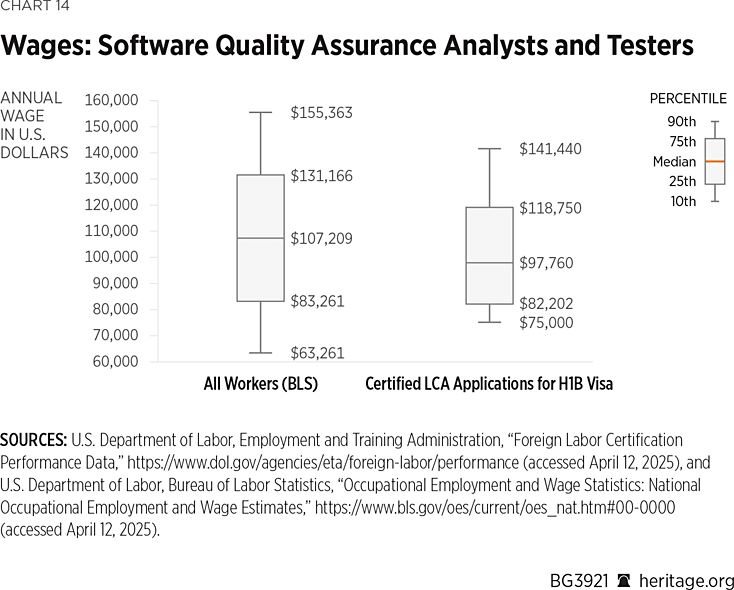
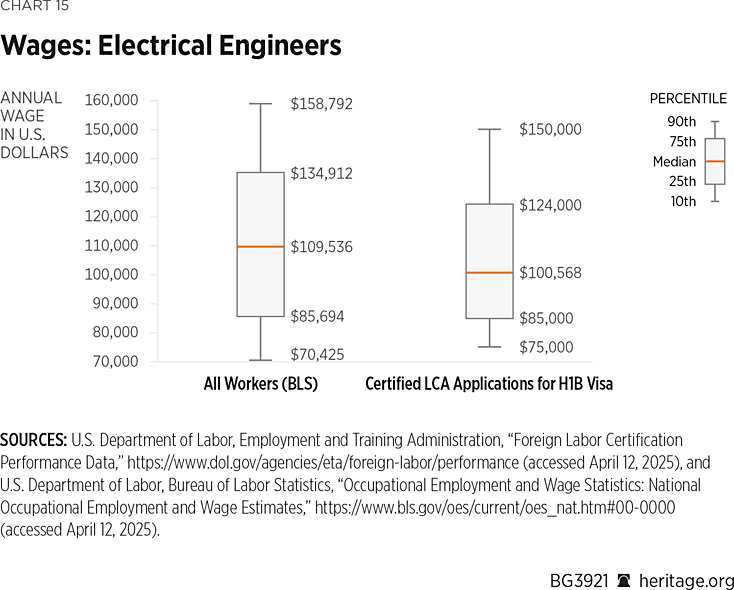
As is evident in Chart 9, LCA applicants for the H-1B visa ended up with significantly lower salary proposals than their native counterparts. The wage distribution data for six technical occupations shows that H-1B visa recipients consistently earn less than their U.S. counterparts across the 10th, 25th, median, 75th, and 90th percentiles. For Computer Systems Analysts (SOC code 15-1211), H-1B wages span from $90,108 (25th percentile) to $120,000 (75th percentile), with a median of $103,854, all lower than the BLS figures: $85,598 (25th percentile), $110,562 (median), and $137,193 (75th percentile). The gap is even more noticeable for Computer Programmers (SOC code 15-1251), where H-1B wages range from $77,000 to $106,027 with a median of $87,277—significantly below the BLS’s $80,935 (25th percentile), $105,708 (median), and $134,069 (75th percentile).
Software Developers (SOC code 15-1252) present a slightly narrower disparity. H-1B workers earn from $99,008 (25th percentile) to $140,000 (75th percentile), with a median of $115,918, while BLS data reports $102,161, $130,325, and $157,463, respectively. Software Quality Assurance Analysts and Testers (SOC code 15-1253) show a similar pattern, with H-1B median wages at $97,760 and BLS at $107,209. The upper end also diverges, with 90th percentile wages at $205,000 for BLS workers versus $170,000 for H-1B holders. Among engineers, Electrical Engineers (SOC code 17-2071) and Mechanical Engineers (SOC code 17-2141) both show H-1B median wages below $101,000, compared to $109,536 and $100,079, respectively, for all workers.
In every case, H-1B wage distributions are systematically lower at every percentile point, from the 10th to the 90th, suggesting structural differences that may relate to job roles, experience levels, or employer-specific practices in H-1B sponsorship. This pattern reinforces findings from the previous section, where the majority of certified H-1B positions fell into the lower wage levels (I and II). These wage differentials create economic incentives for firms to favor H-1B workers over similarly skilled U.S. workers, particularly when long-term employment is involved. Implementing a wage-based selection mechanism would help to realign the program with its original intent, favoring truly high-skilled talent, by discouraging low-wage placements and ensuring that roles offering competitive compensation are prioritized.
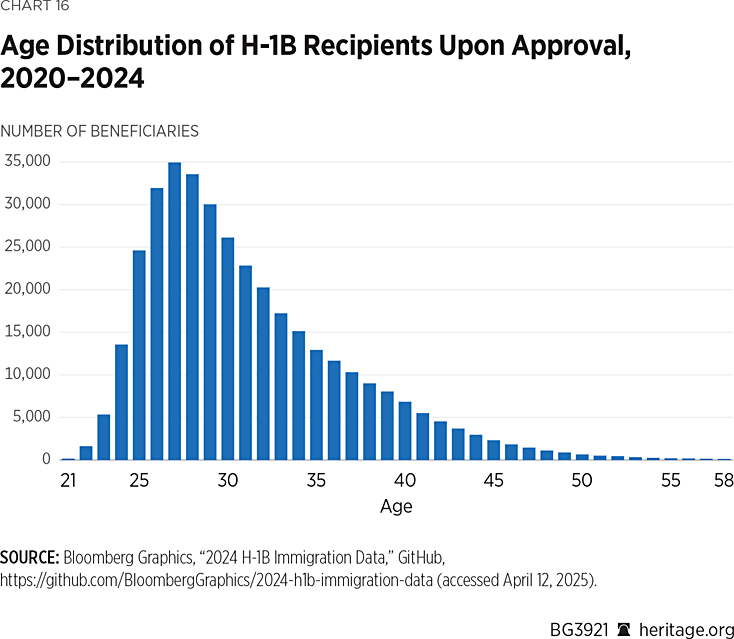
Part of the wage discount observed among H-1B workers can be attributed to the demographic composition of the program. In recent years, the H-1B visa has increasingly functioned as a pipeline for bringing in young workers, often recent graduates with strong technical skills, rather than as a tool for hiring highly experienced specialists. This shift in usage helps to explain observed wage differentials and reflects the evolving role of the program in meeting labor market needs. In part, this shift toward younger talent could be due to a reduction in labor force participation among younger Americans.REF
As shown in Chart 16, the vast majority of beneficiaries fall within the 25-to-30 age range, with 27 being the age with the most approvals. Members of this group, often early in their careers, typically lack the extensive experience that would justify commanding higher salaries. The program, therefore, disproportionately favors younger workers who are more affordable for employers.
Table 2 reinforces this trend. It presents the number of H-1B approvals by age bracket along with corresponding mean and median wages. Workers in their early 20s and late 20s have significantly lower wages than those in their 40s and 50s. For instance, while the mean wage for 25-to-29-year-olds is around $101,813, it jumps to $119,207 for 45-to-49-year-olds, and even higher for older cohorts.
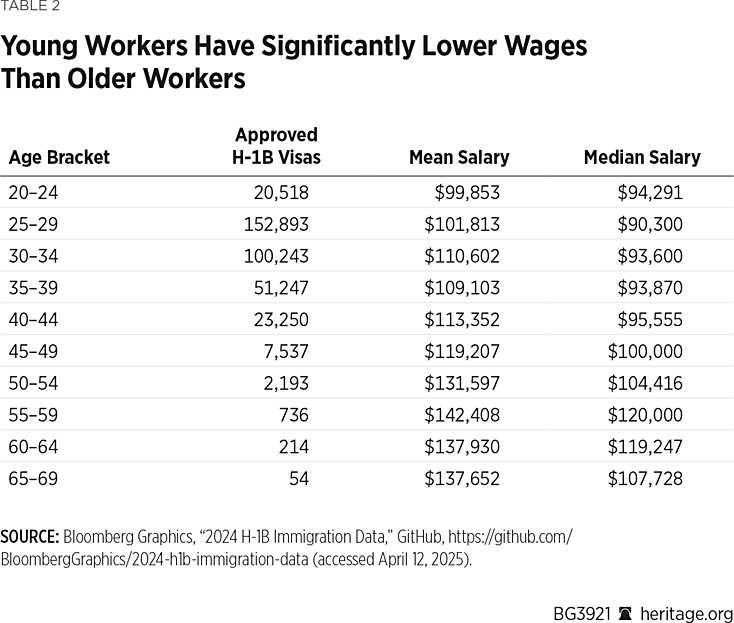
Realities of the H-1B Program
The H-1B visa was originally intended as a mechanism to help U.S. employers to address genuine shortages in high-skilled labor markets. In practice, however, its design, particularly the randomized lottery used to allocate most visas, means it does not reliably target the most critical workforce needs. Employers hoping to fill highly specialized roles requiring niche expertise have no guarantee of securing a visa, while other firms may successfully sponsor workers for roles that are more generic, less urgent, or less in demand from a national perspective. This makes the program ill-suited to function as an efficient labor market tool.
At the same time, the structure of the H-1B program imposes deliberate constraints that limit worker mobility.REF Because the visa is tied to a specific employer, workers face substantial friction if they seek to change jobs. These constraints lead to labor market “stickiness,” where workers are more likely to stay in their current positions even for a lower wage.
Significantly, this stickiness is not just a cost, it can also be an incentive. From an employer’s perspective, the limited job mobility of H-1B workers may make them more attractive than native workers, who are free to leave at any time. But this creates an uneven playing field: Native workers, who are free to switch jobs or negotiate better pay, may be overlooked not because they lack skills, but because they are not as easily retained or controlled. As a result, employers may favor visa-bound workers who accept lower wages and fewer demands, driving down bargaining power and wage growth for equally or more qualified U.S. workers.REF
“Multiple Registration” Loophole Recently Ended. A Bloomberg investigation revealed that from 2020 to 2023, the H-1B skilled-worker visa lottery was exploited by staffing and outsourcing firms through a loophole that allowed multiple lottery registrations for the same individual.REF This practice, known as “multiple registration,” let firms dramatically increase the odds of selection for their candidates by submitting dozens of entries under different affiliated companies. While Amazon and Google submitted limited, targeted entries, Cognizant—a New Jersey–based IT services firm with strong ties to India—and other firms used bulk strategies to crowd the system, often without real jobs in place. As a result, nearly half of all H-1B visas were awarded to firms offering lower wages and less-skilled roles, distorting the program’s intent to attract top global talent.REF
Fortunately, in 2024, USCIS implemented a key reform that eliminated this vulnerability. Now, the lottery selects unique individuals—not entries—ensuring that each candidate has only one chance of selection, regardless of how many employers register them.REF
Rank-Order Application Process: A Chance to Fix the Broken H-1B System
One effective policy reform would be to rank H-1B visa applications by offered wage level, giving priority to employers offering the highest salaries. This approach assumes that higher wages reflect higher skill levels, more specialized knowledge, or critical labor shortages, aligning better with the stated goal of the H-1B program: attracting the world’s “best and brightest.”
Under this wage-based rank-ordering system, applications would not be selected randomly (as in the current lottery system), but ranked from highest-offered to lowest-offered wage, and approvals would be granted in that order. This would encourage employers to offer competitive wages, help to reduce abuse by low-cost outsourcing firms, and minimize displacement of similarly skilled U.S. workers.
Critics of a wage-based ranking system argue that it could disadvantage applicants from regions with generally lower average wages, such as Mecklenburg County, North Carolina. To address this concern, this Backgrounder proposes ranking applicants based on the BLS’s wage data, which accounts for regional differences in labor markets. This approach evaluates how competitive the offered salary is relative to local wage norms, rather than in absolute terms. In practice, this means that a candidate who is offered $100,000 in a lower-cost region could be ranked more favorably than a candidate who is offered $105,000 in a high-cost region, if the former salary significantly exceeds the local market wage benchmark.
The Biden Administration reversed a pair of rules from President Trump’s first term that would have replaced the random lottery with a wage-based selection system of this nature, prioritizing higher-paid H-1B applicants. This proposal was blocked by a federal court and later formally withdrawn by the Biden USCIS. The court’s decision prevented implementation of both rules because it deemed that the government did not meet the “good cause” standard required to forego the notice-and-comment requirement before finalizing a new regulation.REF The current Trump Administration has notified the Office of Management and Budget of a proposed rule with a “weighted selection process” for the visa. The notification does not describe the new selection process if a rule is adopted but the current Trump Administration should again issue visas based at least significantly on salary level.REF
To quantify the impact of such a rank-ordering system on the H-1B market, we ran a simulation that filters and certifies only the top 70,000 applications based on wage levels by year. This process mimics how a market-based or point-based system might prioritize high-skilled, high-wage applicants. Using actual certified petition data, this analysis calculated wage distributions (10th, 25th, median, 75th, and 90th percentiles) for the selected occupations and compared them to wage benchmarks from the BLS.
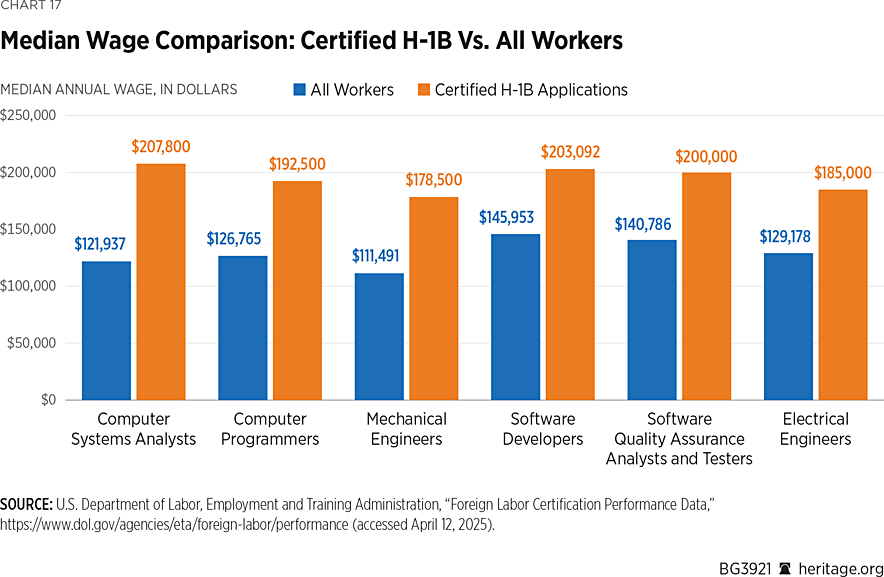
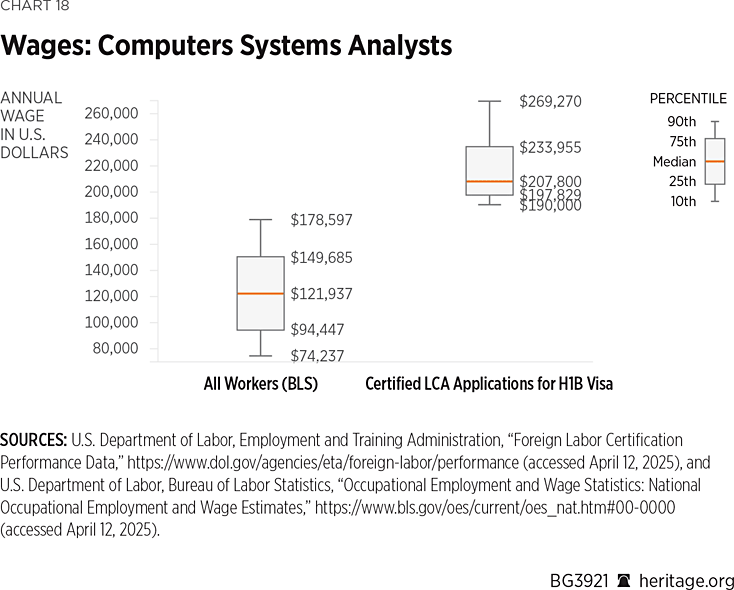
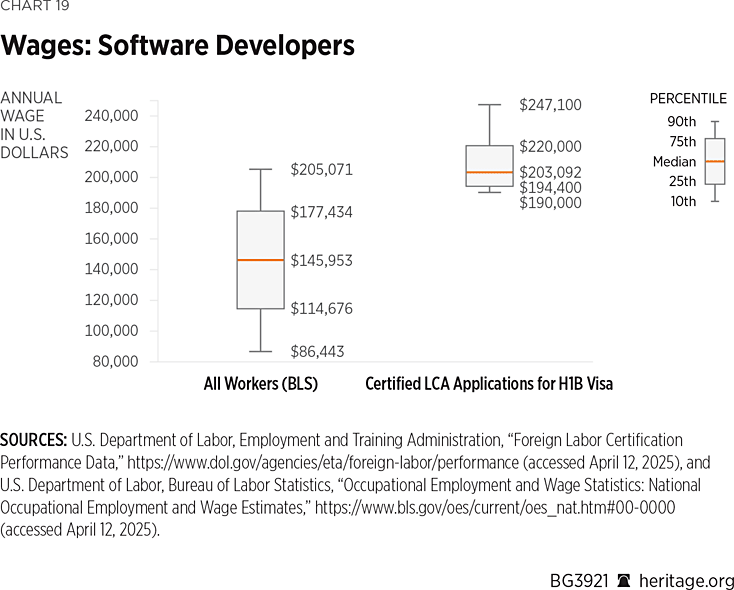
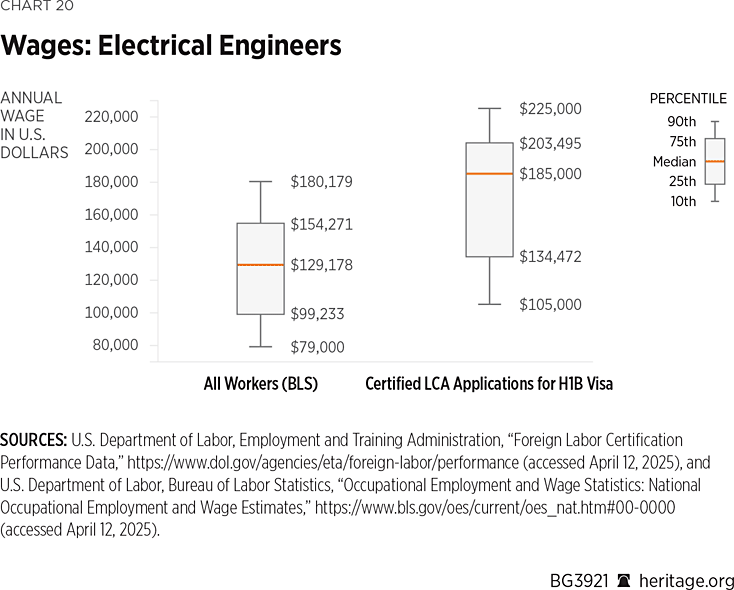
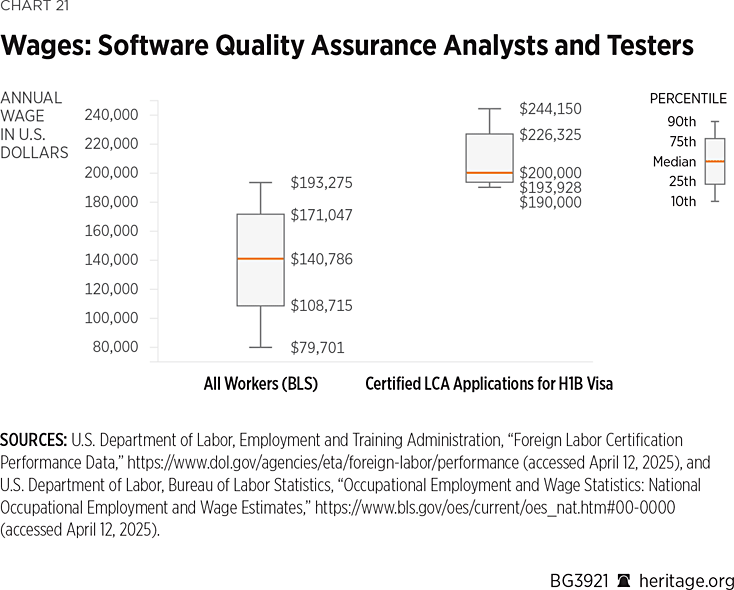
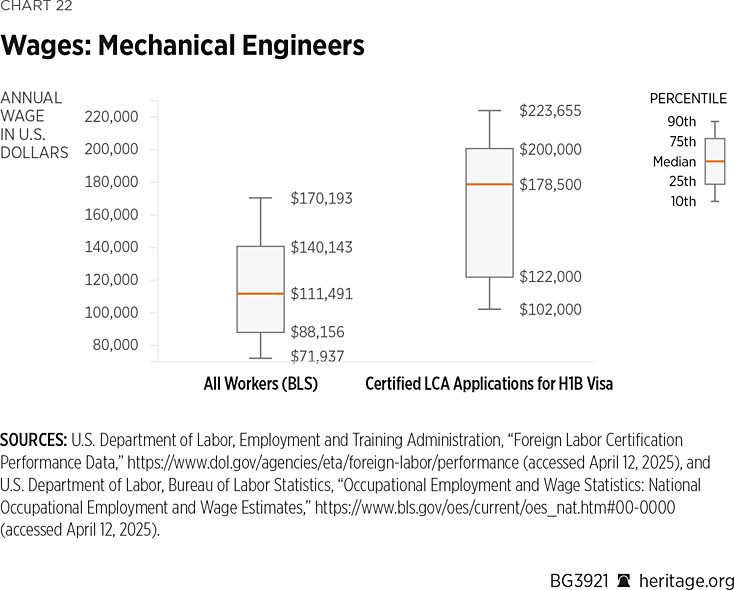
As Chart 17 illustrates, the average wage offered across all occupations increases significantly under the proposed policy. In the case of software developers, for example, the new median wage for certified H-1B applicants aligns with the 90th percentile of wages in the field. This shift indicates that the rank-ordering system is effectively selecting applicants at the very top of the labor market who are not only highly skilled but also commanding salaries that reflect their value. In doing so, the policy aligns the H-1B program with its original purpose: to supplement the U.S. workforce with exceptional talent, not to undercut it.
Conclusion
The overall wage-level concentration presented in Chart 9 has significant policy implications. The current H-1B visa program tends to displace U.S. workers, especially when employers use the visa to reduce labor costs rather than to fill skill gaps. Intended to attract the world’s top talent, the program has drifted far from its stated mission. Congress must fundamentally reform the H-1B program, not only to ensure that it truly attracts the most qualified foreign workers for high-demand positions, but to also safeguard employment opportunities for Americans. It is time for Congress to replace the lottery with a rank-order system.
Alexander Frei is a former Senior Research Associate in the Center for Data Analysis at The Heritage Foundation.












